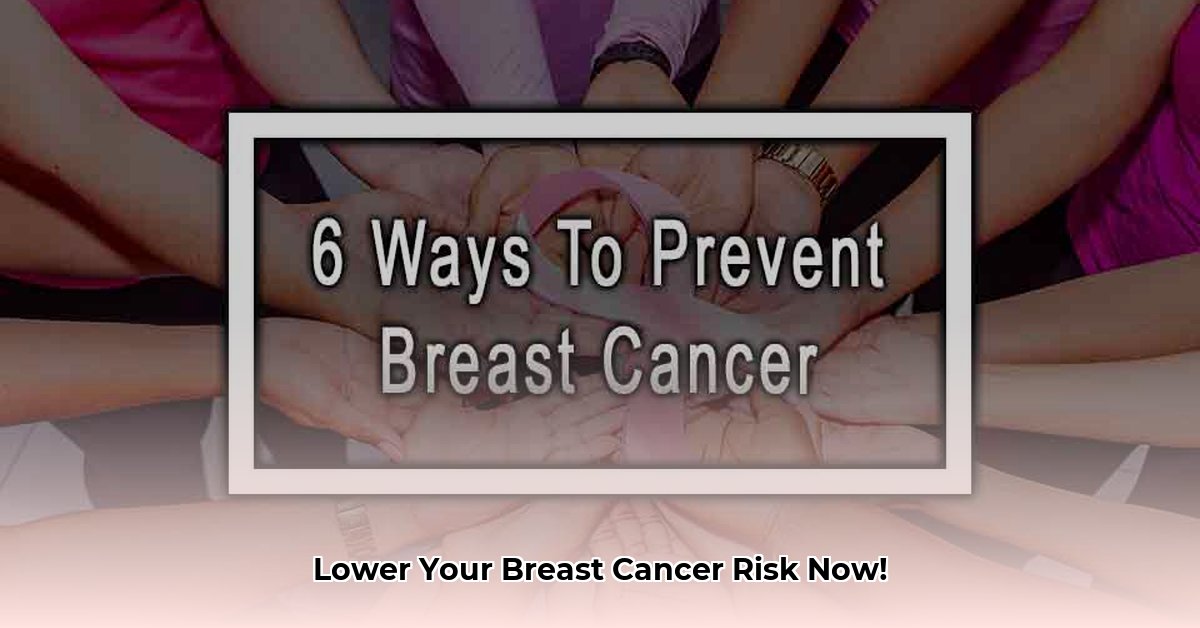Understanding Your Risk
Understanding your risk for breast cancer can feel daunting, but knowledge is power. Some risk factors are inherent, like aging, family history (including genetic predispositions like BRCA mutations), and personal medical history (such as prior breast conditions or chest radiation). Other factors, like early menstruation, late menopause (resulting in prolonged estrogen exposure), and breast density, are also not modifiable. Recognizing these factors helps you and your doctor tailor a preventive strategy.
Taking Proactive Steps
While some risks are unavoidable, many lifestyle choices can significantly impact your breast health. Maintaining a healthy weight is likely crucial, as is regular physical activity, even moderate exercise like brisk walking. For women who have had children, breastfeeding may offer some protection. Limiting alcohol consumption, carefully considering hormone therapy after menopause with your doctor, and adopting a diet rich in fruits, vegetables, and whole grains are also beneficial steps.
Early Detection Matters
Early detection dramatically improves breast cancer outcomes. Regular self-exams familiarize you with your normal breast tissue, making it easier to notice changes. Clinical breast exams by a healthcare professional and mammograms are vital screening tools. Your doctor will recommend a mammogram schedule based on your risk factors. Some women, especially those at higher risk, may also require breast MRIs. Open communication with your doctor is key to developing a personalized screening plan.
Debunking Myths
Misinformation about breast cancer can be confusing. Myths about antiperspirants, underwire bras, and abortions causing breast cancer are not scientifically supported. Focus on evidence-based information and consult reputable sources like the American Cancer Society or the National Cancer Institute.
Genetic Testing and Counseling
If breast cancer runs in your family, genetic testing and counseling can clarify your risk based on your genetic profile. This personalized information guides decisions about prevention and early detection.
Lifestyle Changes: Small Changes, Big Impact
Even small lifestyle adjustments can significantly reduce your risk. A balanced diet with ample fruits, vegetables, and whole grains, combined with regular physical activity (at least 150 minutes of moderate-intensity aerobic exercise per week), makes a considerable difference. Maintaining a healthy weight is an ongoing effort, not a one-time achievement.
Partnering with Your Doctor
Your doctor is your ally in breast cancer prevention. Discuss your concerns, risk factors, and prevention strategies openly. Together, you can create a personalized plan.
Key Prevention Strategies
| Strategy | Actionable Steps |
|---|---|
| Maintain a Healthy Weight | Strive for a BMI within the recommended range. Consult your doctor for personalized guidance. |
| Stay Active | Aim for 150 minutes of moderate-intensity or 75 minutes of vigorous-intensity exercise weekly. |
| Choose a Healthy Diet | Prioritize fruits, vegetables, whole grains, and limit processed foods, sugary drinks, and red meat. |
| Limit Alcohol | If you drink alcohol, do so in moderation (no more than one drink per day for women). |
| Breastfeed, If Possible | Consider breastfeeding for at least six months. |
| Informed Decisions on HRT | Discuss the benefits and risks of hormone therapy after menopause with your doctor. |
| Regular Screening | Follow recommended guidelines for mammograms, clinical breast exams, and self-exams. |
| Genetic Testing/Counseling | Consider this if you have a strong family history of breast or ovarian cancer. |
Delving Deeper into Risk Factors
Understanding your risk factors is crucial for effective prevention. Some factors are non-modifiable:
- Age: Risk increases with age.
- Genetics: Inherited gene mutations (like BRCA1/2) significantly elevate risk.
- Family History: Having close relatives with breast or ovarian cancer increases your risk.
- Reproductive History: Early menstruation, late menopause, and higher lifetime estrogen exposure are linked to increased risk.
- Breast Density: Dense breast tissue can make it harder to detect tumors on mammograms.
- Personal History: Previous breast cancer or some benign breast conditions increase the risk of recurrence.
- Past Radiation Exposure: Chest radiation, particularly before age 30, increases risk.
- DES Exposure: Exposure in utero to diethylstilbestrol (DES) may slightly increase risk.
However, modifiable risk factors offer opportunities for proactive prevention:
- Weight: Maintaining a healthy weight, particularly after menopause, is essential.
- Physical Activity: Regular exercise likely helps regulate hormones and boost the immune system.
- Alcohol Consumption: Limiting alcohol intake is advisable, as even moderate consumption may slightly increase risk.
- Hormone Therapy: Long-term combined HRT (estrogen and progestin) can increase risk. Discuss the risks and benefits with your doctor.
- Reproductive Choices: Factors like age at first full-term pregnancy and breastfeeding may impact risk.
- Emerging Research: Studies are exploring potential links between smoking, exposure to certain chemicals, and night shift work with breast cancer risk. More research is needed to confirm these associations.
It’s also important to address common misconceptions. Underwire bras, breast implants, deodorants, mammograms, and caffeine have not been definitively linked to increased breast cancer risk.
Medical Strategies for Risk Reduction: Beyond Lifestyle
Beyond lifestyle, medical interventions can further reduce risk in specific circumstances:
- Preventative Medications: SERMs (like tamoxifen and raloxifene) and aromatase inhibitors can reduce risk, especially for those at higher risk. They work by blocking estrogen’s effects or reducing estrogen production.
- Preventive Surgery: In high-risk cases (e.g., BRCA mutations and strong family history), prophylactic mastectomy (breast removal) or oophorectomy (ovary removal) might be considered. These are significant decisions with substantial implications and should be thoroughly discussed with your medical team.
- Increased Surveillance: High-risk individuals may benefit from more frequent screenings (mammograms, ultrasounds, MRIs).
The Importance of Nutrition
While the exact relationship between diet and breast cancer is still being researched, a healthy diet likely supports overall health and well-being. Focus on fruits, vegetables, whole grains, and limit red and processed meats. Some studies suggest the benefits of healthy fats, such as those found in the Mediterranean diet.
Remember: This information is for educational purposes and doesn’t replace professional medical advice. Always consult your doctor for personalized guidance.







